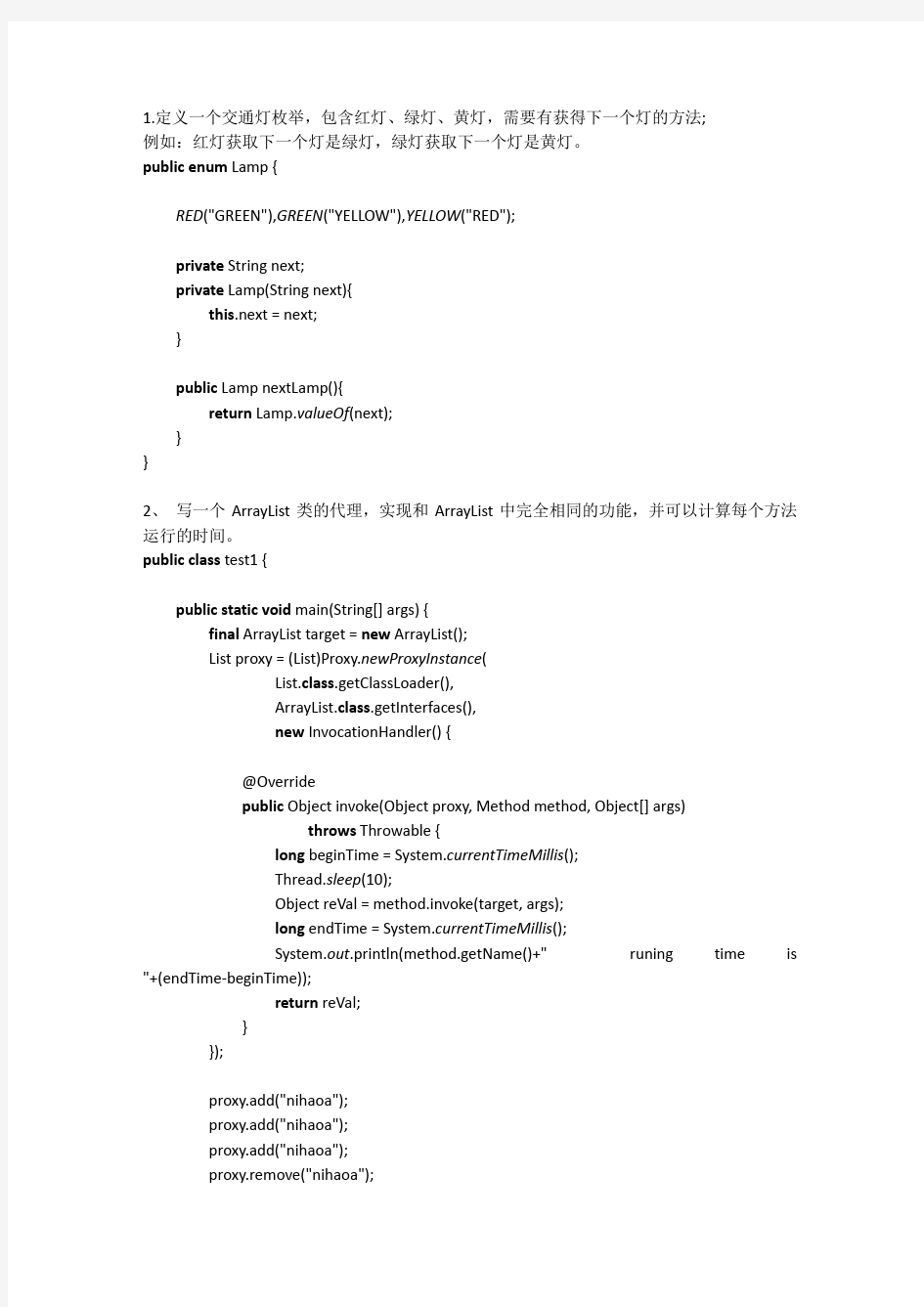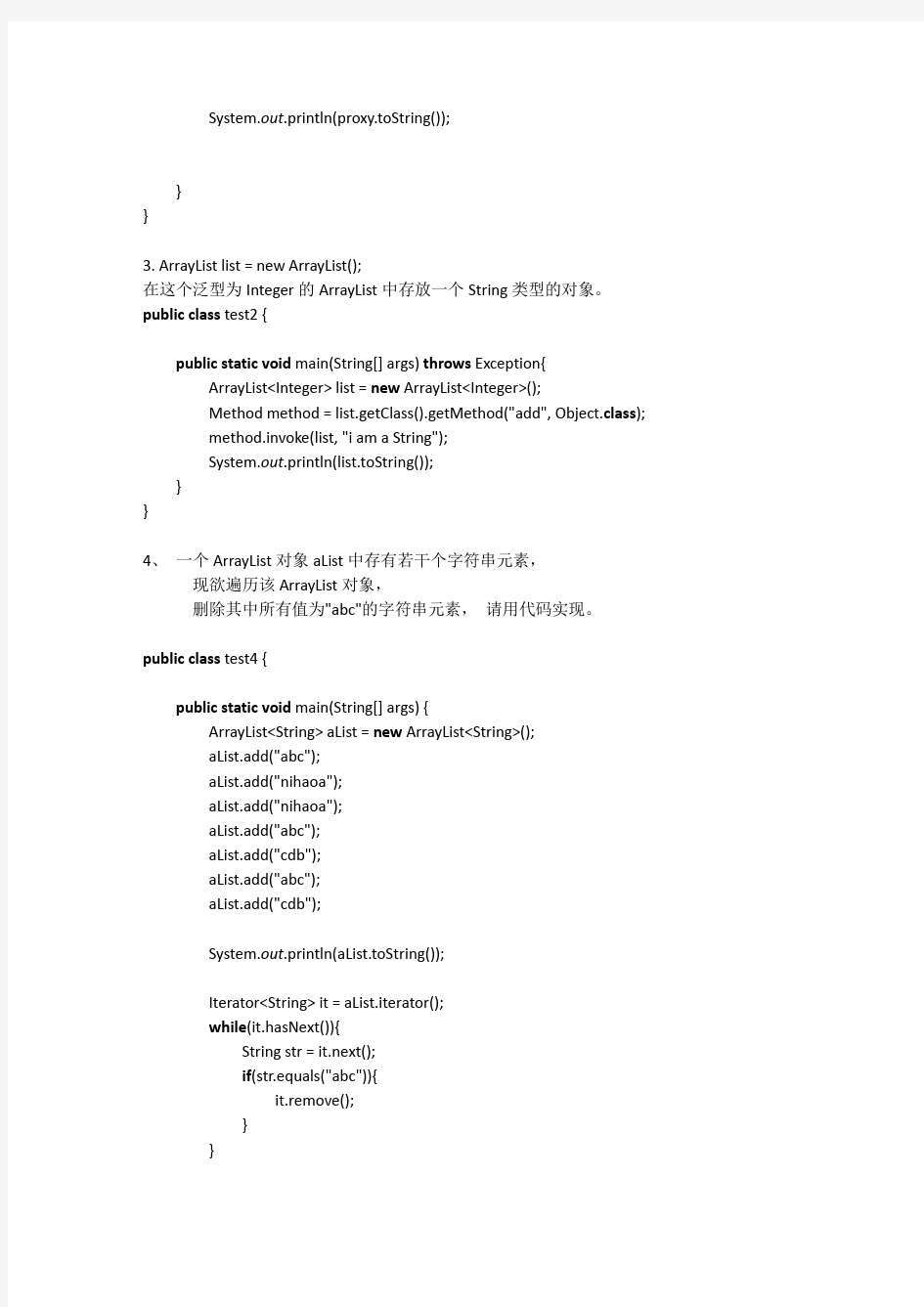

1.定义一个交通灯枚举,包含红灯、绿灯、黄灯,需要有获得下一个灯的方法;
例如:红灯获取下一个灯是绿灯,绿灯获取下一个灯是黄灯。
publicenum Lamp {
RED("GREEN"),GREEN("YELLOW"),YELLOW("RED");
private String next;
private Lamp(String next){
this.next = next;
}
public Lamp nextLamp(){
return Lamp.valueOf(next);
}
}
2、写一个ArrayList类的代理,实现和ArrayList中完全相同的功能,并可以计算每个方法运行的时间。
publicclass test1 {
publicstaticvoid main(String[] args) {
final ArrayList target = new ArrayList();
List proxy = (List)Proxy.newProxyInstance(
List.class.getClassLoader(),
ArrayList.class.getInterfaces(),
new InvocationHandler() {
@Override
public Object invoke(Object proxy, Method method, Object[] args)
throws Throwable {
long beginTime = System.currentTimeMillis();
Thread.sleep(10);
Object reVal = method.invoke(target, args);
long endTime = System.currentTimeMillis();
System.out.println(method.getName()+" runing time is "+(endTime-beginTime));
return reVal;
}
});
proxy.add("nihaoa");
proxy.add("nihaoa");
proxy.add("nihaoa");
proxy.remove("nihaoa");
}
}
3. ArrayList list = new ArrayList();
在这个泛型为Integer的ArrayList中存放一个String类型的对象。publicclass test2 {
publicstaticvoid main(String[] args) throws Exception{
ArrayList
Method method = list.getClass().getMethod("add", Object.class);
method.invoke(list, "i am a String");
System.out.println(list.toString());
}
}
4、一个ArrayList对象aList中存有若干个字符串元素,
现欲遍历该ArrayList对象,
删除其中所有值为"abc"的字符串元素,请用代码实现。
publicclass test4 {
publicstaticvoid main(String[] args) {
ArrayList
aList.add("abc");
aList.add("nihaoa");
aList.add("nihaoa");
aList.add("abc");
aList.add("cdb");
aList.add("abc");
aList.add("cdb");
System.out.println(aList.toString());
Iterator
while(it.hasNext()){
String str = it.next();
if(str.equals("abc")){
it.remove();
}
}
}
}
5、编写一个类,增加一个实例方法用于打印一条字符串。
并使用反射手段创建该类的对象,并调用该对象中的方法。
publicclass test5 {
publicstaticvoid main(String[] args)throws Exception {
Class
Method method = clazz.getMethod("printStr", String.class);
method.invoke(clazz.newInstance(), "nihao ma? this my print str");
}
}
class myClass{
publicvoid printStr(String str){
System.out.println(str);
}
}
6 、存在一个JavaBean,它包含以下几种可能的属性:1:boolean/Boolean
2:int/Integer
3:String
4:double/Double 属性名未知,现在要给这些属性设置默认值,以下是要求的默认值:String类型的默认值为字符串https://www.doczj.com/doc/768213617.html, int/Integer类型的默认值为100 boolean/Boolean类型的默认值为true
double/Double的默认值为0.01D.
只需要设置带有getXxx/isXxx/setXxx方法的属性,非JavaBean属性不设置,请用代码实现publicclass test7 {
publicstaticvoid main(String[] args) throws Exception {
Class clazz = Class.forName("cn.heima.test.testBean");
Object bean = clazz.newInstance();
BeanInfobeanInfo = Introspector.getBeanInfo(clazz);
// System.out.println(beanInfo);
PropertyDescriptor[] propertyDescriptors = beanInfo
.getPropertyDescriptors();
for (PropertyDescriptorpd : propertyDescriptors) {
// System.out.println(pd);
// 获取属性名
Object name = pd.getName();
// 获取属性类型
Object type = pd.getPropertyType();
// 获取get方法
Method getMethod = pd.getReadMethod();
// 获取set方法
Method setMethod = pd.getWriteMethod();
if (!"class".equals(name)) {
if (setMethod != null) {
if (type == boolean.class || type == Boolean.class) {
setMethod.invoke(bean, true);
}
if (type == String.class) {
setMethod.invoke(bean, "https://www.doczj.com/doc/768213617.html,");
}
if (type == int.class || type == Integer.class) {
setMethod.invoke(bean, 100);
}
if (type == double.class || type == Double.class) {
setMethod.invoke(bean, 0.01D);
}
}
if (getMethod != null) {
System.out.println(type + " " + name + "="
+ getMethod.invoke(bean, null));
}
}
}
}
}
class testBean {
privateboolean b;
private Integer i;
private String str;
private Double d;
public Boolean getB() {
return b;
}
publicvoid setB(Boolean b) {
this.b = b;
}
public Integer getI() {
return i;
}
publicvoid setI(Integer i) {
this.i = i;
}
public String getStr() {
return str;
}
publicvoid setStr(String str) {
this.str = str;
}
public Double getD() {
return d;
}
publicvoid setD(Double d) {
this.d = d;
}
}
7、定义一个文件输入流,调用read(byte[] b)
方法将exercise.txt文件中的所有内容打印出来(byte数组的大小限制为5,不考虑中文编码问题)。
publicclass test8 {
publicstaticvoid main(String[] args) {
FileInputStreamfr = null;
try {
fr = new FileInputStream("d:/exercise.txt");
byte[] bt = newbyte[5];
int len = 0;
while((len = fr.read(bt))!=-1){
for (int i = 0; i System.out.print((char)bt[i]); } } } catch (IOException e) { // TODO Auto-generated catch block e.printStackTrace(); }finally{ if(fr!=null){ try { fr.close(); } catch (IOException e) { e.printStackTrace(); }finally{ fr = null; } } } } } 8、编写一个程序,它先将键盘上输入的一个字符串转换成十进制整数,然后打印出这个十进制整数对应的二进制形式。 这个程序要考虑输入的字符串不能转换成一个十进制整数的情况,并对转换失败的原因要区分出是数字太大,还是其中包含有非数字字符的情况。提示:十进制数转二进制数的方式是用这个数除以2,余数就是二进制数的最低位,接着再用得到的商作为被除数去除以2 ,这次得到的余数就是次低位,如此循环,直到被除数为0为止。其实,只要明白了打印出一个十进制数的每一位的方式(不断除以10,得到的余数就分别是个位,十位,百位),就很容易理解十进制数转二进制数的这种方式。 publicclass test9 { publicstaticvoid main(String[] args) { Scanner sc = null; while (true) { sc = new Scanner(System.in); String str = sc.nextLine(); int a = 0; if (isOctNumers(str)) { a = Integer.valueOf(str); } else { System.out.println("输入不正确,请重新输入"); continue; } System.out.println(toBinary(a)); sc.close(); } } privatestaticboolean isOctNumers(String str) { try { Integer.parseInt(str); returntrue; } catch (NumberFormatException e) { returnfalse; } } publicstatic String toBinary(Integer decimal) { StringBuildersb = new StringBuilder(); int x = 0; while (decimal != 0) { x = decimal % 2; decimal = (int) (decimal / 2); sb.append(x); } sb.reverse(); return sb.toString(); } } 9、金额转换,阿拉伯数字转换成中国传统形式。例如:101000001010 转换为壹仟零壹拾亿零壹仟零壹拾圆整 publicclass testt10 { privatestaticfinalchar[] data = { '零', '壹', '贰', '叄', '肆', '伍', '陆', '柒', '捌', '玖' }; privatestaticfinalchar[] units = { '圆', '拾', '佰', '仟', '万', '拾', '佰', '仟', '亿', '拾', '佰', '仟' }; @SuppressWarnings("resource") publicstaticvoid main(String[] args) { while (true) { Scanner sc = new Scanner(System.in); long l = sc.nextLong(); System.out.println(convert(l)); } } publicstatic String convert(long money) { StringBuffersbf = new StringBuffer(); int uint = 0; while (money != 0) { sbf.insert(0, units[uint++]); sbf.insert(0, data[(int) (money % 10)]); money = money / 10; } // 去零 return sbf.toString().replaceAll("零[仟佰拾]", "零").replaceAll("零+万", "万") .replaceAll("零+亿", "亿").replaceAll("亿万", "亿零") .replaceAll("零+", "零").replaceAll("零圆", "圆"); } } 10.取出一个字符串中字母出现的次数。如:字符串:"abcde%^kka27qoq" ,输出格式为:a(2)b(1)k(2)... publicclass test1 { publicstaticvoid main(String[] args) { String str = "abcdekka27qoA*&AAAq"; CountChar(str); } privatestaticvoid CountChar(String str) { char[] c = str.toCharArray(); System.out.println(c); Map for (int i = 0; i if ((c[i] <= 90 && c[i] >= 65)||(c[i]>=97&&c[i]<=112)) { if (!(map.keySet().contains(c[i]))) { map.put(c[i], 1); } else { map.put(c[i], map.get(c[i]) + 1); } } } StringBuildersb = new StringBuilder(); Iterator while (it.hasNext()) { Map.Entry sb.append(entry.getKey() + "(" + entry.getValue() + ")"); } System.out.println(sb); } } /** *11、将字符串中进行反转。abcde -->edcba */ publicclass test5 { publicstaticvoid main(String[] args) { String str = "abcdgrdfgse"; System.out.println(reverse(str)); } privatestatic String reverse(String str) { String result = ""; char[] c = str.toCharArray(); for (int i = c.length-1; i >= 0 ; i--) { result += c[i]; } return result; } } /** * 12、 * 已知文件a.txt文件中的内容为“bcdeadferwplkou”,请编写程序读取该文件内容,并按照自然顺序排序后输出到b.txt文件中。即b * .txt中的文件内容应为“abcd…………..”这样的顺序。 */ publicclass test6 { publicstaticvoid main(String[] args) { FileInputStreamfis = null; FileOutputStreamfos = null; try { fis = new FileInputStream("D:/a.txt"); fos = new FileOutputStream("D:/b.txt"); byte[] c = newbyte[fis.available()]; while (fis.read(c) != -1) { Arrays.sort(c); fos.write(c); } fos.flush(); } catch (IOException e) { // TODO Auto-generated catch block e.printStackTrace(); } finally { try { fis.close(); } catch (IOException e) { // TODO Auto-generated catch block e.printStackTrace(); } try { fos.close(); } catch (IOException e) { // TODO Auto-generated catch block e.printStackTrace(); } } } } /** * 13、编写一个程序,获取10个1至20的随机数,要求随机数不能重复。*/ publicclass test7 { publicstaticvoid main(String[] args) { System.out.println(getRandom()); } publicstatic List Random rd = new Random(); ArrayList int i = 0; while(i!=10){ int r = rd.nextInt(20); if(!al.contains(rd)){ al.add(r); i++; } } return al; } } /** * 14、编写三各类Ticket、SealWindow、TicketSealCenter分别代表票信息、售票窗口、售票中心。售票中心分配一定数量的票, * 由若干个售票窗口进行出售,利用你所学的线程知识来模拟此售票过程。 */ publicclass test8 { publicstaticvoid main(String[] args) { Ticket ticket = Ticket.getInstance(); ticket.setNumber(1000); new SealWindow("1号窗口").start(); new SealWindow("2号窗口").start(); new SealWindow("3号窗口").start(); new SealWindow("4号窗口").start(); } } class Ticket { privatestatic Ticket ticket = new Ticket(); private Ticket() { } publicstatic Ticket getInstance() { return ticket; } privateint number; publicvoid setNumber(int number) { this.number = number; } publicint getNumber() { return number; } publicboolean isHasTicket() { if (number > 0) returntrue; returnfalse; } publicvoid sealTicket() { number--; } } class SealWindow { private String name; public SealWindow(String name) { https://www.doczj.com/doc/768213617.html, = name; } publicvoid start() { Executors.newScheduledThreadPool(1).execute(new Runnable() { Ticket ticket = Ticket.getInstance(); @Override publicvoid run() { while (ticket.isHasTicket()) { synchronized (Ticket.class) { if(!ticket.isHasTicket())continue; try { Thread.sleep(10); } catch (InterruptedException e) { // TODO Auto-generated catch block e.printStackTrace(); } ticket.sealTicket(); System.out.println(name + "售出" + (ticket.getNumber() + 1) + "号票"); } } } }); } } class TicketSealCenter { } /** * * 15、自定义枚举Week 用于表示星期,Mon,Tue,Wed...要求每个枚举值都有toLocaleString * 方法,用于获得枚举所表示的星期的中文格式星期一、星期二、星期三... * */ publicenum Week { Mon { @Override public String toLocaleString() { return "星期一"; } },Tue { @Override public String toLocaleString() { return "星期二"; } },Wed { @Override public String toLocaleString() { return "星期三"; } },Thu { @Override public String toLocaleString() { return "星期四"; } },Fri { @Override public String toLocaleString() { return "星期五"; } },Sat { @Override public String toLocaleString() { return "星期六"; } },Sun { @Override public String toLocaleString() { return "星期天"; } }; /*private String next; private Week(String next){ }*/ publicabstract String toLocaleString(); } /** * 16、已知一个int类型的数组,用冒泡排序法将数组中的元素进行升序排列。* @author Administrator * */ publicclass test1 { publicstaticvoid main(String[] args) { //定义一个数组 int[] arr = newint[]{2,1,5,4,6,4,5,4,5,4,10,9}; //调用BubbleSort方法对数组进行排序 BubbleSort(arr); //输出排序后的数组 System.out.println(Arrays.toString(arr)); } /** * 这一个使用冒泡排序使int型数组内元素按照升序重新排序的算法 * @param arr接收一个int型数组 */ publicstaticvoid BubbleSort(int[] arr){ //定义一个临时变量 int temp = 0; for (int i = arr.length - 1; i > 0; --i) { for (int j = 0; j < i; ++j) { if (arr[j] >arr[j+1]) { //重复比较相邻元素,如果前一个比后一个大,则交换. //利用中间变量temp,对arr[j]和arr[j+1]对换 temp = arr[j]; arr[j] = arr[j + 1]; arr[j + 1] = temp; } } } } }